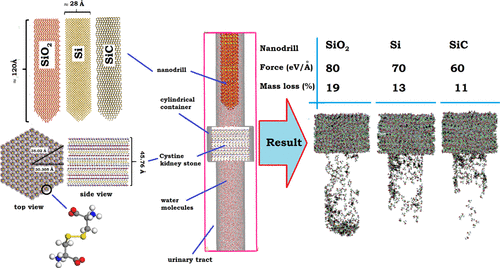当前位置:
X-MOL 学术
›
J. Phys. Chem. B
›
论文详情
Our official English website, www.x-mol.net, welcomes your feedback! (Note: you will need to create a separate account there.)
Atomistic Assessment of Cystine Kidney Stone Behavior in a Mechanical Breakdown Process by Nanobiorobots through Classical Molecular Dynamics Simulations
The Journal of Physical Chemistry B ( IF 3.3 ) Pub Date : 2021-08-31 , DOI: 10.1021/acs.jpcb.1c04682 Moharram Habibnejad-Korayem 1 , Omid Nabiei 1 , Sima Gharibshah 2 , Rouzbeh Nouhi-Hefzabad 1
The Journal of Physical Chemistry B ( IF 3.3 ) Pub Date : 2021-08-31 , DOI: 10.1021/acs.jpcb.1c04682 Moharram Habibnejad-Korayem 1 , Omid Nabiei 1 , Sima Gharibshah 2 , Rouzbeh Nouhi-Hefzabad 1
Affiliation

|
Because cystine kidney stones are a more serious challenge for health-related quality of life than other types of kidney stones, the search for a new treatment for cystinuria is considered the main goal of this study. To achieve the defined goal, classical molecular dynamics simulations and quantum mechanics calculations were implemented in this study. Three nanodrills with different stiffnesses (i.e., silicon, silica, and silicon carbide) were selected to find the efficient nanodrill to break the kidney stones into smaller pieces. The related nanodrills under various forces from 20 to 100 eV/Å inclusive were exerted on the cystine kidney stones to determine the effect of the force magnitude on the rate of destruction. The exerted forces were modeled via a hypothetical spring force. To bring this investigation closer to reality, the urinary tract and the bulk of cystine kidney stones were modeled by simulation of the real blockage of the kidney stones. The obtained results from quantum mechanics calculations reveal the strong interaction (chemisorption) between the cystine stone components. Moreover, the molecular dynamics simulations show that an increase in force does not necessarily lead to more destruction of cystine kidney stones. The maximum rate of cystine kidney stone destruction occurs under forces of 80, 70, and 60 eV/Å for SiO2, Si, and SiC nanodrills, which is about 19, 13, and 11%, respectively. In addition, the SiO2 nanodrill has more crossing time and z-direction deformation than other nanodrills due to the attractive interaction between SiO2 and stones, it shows less deformation during the process of kidney stone breaking because of repulsive interactions between the nanodrill and the kidney stone.
中文翻译:

纳米生物机器人通过经典分子动力学模拟对机械分解过程中胱氨酸肾结石行为的原子评估
由于胱氨酸肾结石比其他类型的肾结石对健康相关的生活质量构成更严重的挑战,因此本研究的主要目标是寻找一种新的胱氨酸尿症治疗方法。为了实现既定目标,本研究实施了经典分子动力学模拟和量子力学计算。选择了三种不同硬度的纳米钻(即硅、二氧化硅和碳化硅)来寻找有效的纳米钻来将肾结石破碎成更小的碎片。相关的纳米钻在 20 到 100 eV/Å 的各种力下施加在胱氨酸肾结石上,以确定力大小对破坏率的影响。施加的力通过假设的弹簧力建模。为了使这项调查更接近现实,泌尿道和大部分胱氨酸肾结石是通过模拟肾结石的真实阻塞来建模的。从量子力学计算获得的结果揭示了胱氨酸结石成分之间的强相互作用(化学吸附)。此外,分子动力学模拟表明,力的增加并不一定会导致胱氨酸肾结石的更多破坏。对于 SiO,胱氨酸肾结石破坏的最大速率发生在 80、70 和 60 eV/Å 的力下 分子动力学模拟表明,力的增加并不一定会导致更多胱氨酸肾结石的破坏。对于 SiO,胱氨酸肾结石破坏的最大速率发生在 80、70 和 60 eV/Å 的力下 分子动力学模拟表明,力的增加并不一定会导致胱氨酸肾结石的更多破坏。对于 SiO,胱氨酸肾结石破坏的最大速率发生在 80、70 和 60 eV/Å 的力下2、Si和SiC纳米钻头,分别约为19、13和11%。此外,在SiO 2 nanodrill有更多的交叉时间和Ž -方向变形比其它nanodrills由于二氧化硅之间的吸引相互作用2和石头,它肾结石因为nanodrill和之间排斥相互作用的断裂过程中示出了较小的变形肾结石。
更新日期:2021-09-16
中文翻译:

纳米生物机器人通过经典分子动力学模拟对机械分解过程中胱氨酸肾结石行为的原子评估
由于胱氨酸肾结石比其他类型的肾结石对健康相关的生活质量构成更严重的挑战,因此本研究的主要目标是寻找一种新的胱氨酸尿症治疗方法。为了实现既定目标,本研究实施了经典分子动力学模拟和量子力学计算。选择了三种不同硬度的纳米钻(即硅、二氧化硅和碳化硅)来寻找有效的纳米钻来将肾结石破碎成更小的碎片。相关的纳米钻在 20 到 100 eV/Å 的各种力下施加在胱氨酸肾结石上,以确定力大小对破坏率的影响。施加的力通过假设的弹簧力建模。为了使这项调查更接近现实,泌尿道和大部分胱氨酸肾结石是通过模拟肾结石的真实阻塞来建模的。从量子力学计算获得的结果揭示了胱氨酸结石成分之间的强相互作用(化学吸附)。此外,分子动力学模拟表明,力的增加并不一定会导致胱氨酸肾结石的更多破坏。对于 SiO,胱氨酸肾结石破坏的最大速率发生在 80、70 和 60 eV/Å 的力下 分子动力学模拟表明,力的增加并不一定会导致更多胱氨酸肾结石的破坏。对于 SiO,胱氨酸肾结石破坏的最大速率发生在 80、70 和 60 eV/Å 的力下 分子动力学模拟表明,力的增加并不一定会导致胱氨酸肾结石的更多破坏。对于 SiO,胱氨酸肾结石破坏的最大速率发生在 80、70 和 60 eV/Å 的力下2、Si和SiC纳米钻头,分别约为19、13和11%。此外,在SiO 2 nanodrill有更多的交叉时间和Ž -方向变形比其它nanodrills由于二氧化硅之间的吸引相互作用2和石头,它肾结石因为nanodrill和之间排斥相互作用的断裂过程中示出了较小的变形肾结石。


























 京公网安备 11010802027423号
京公网安备 11010802027423号